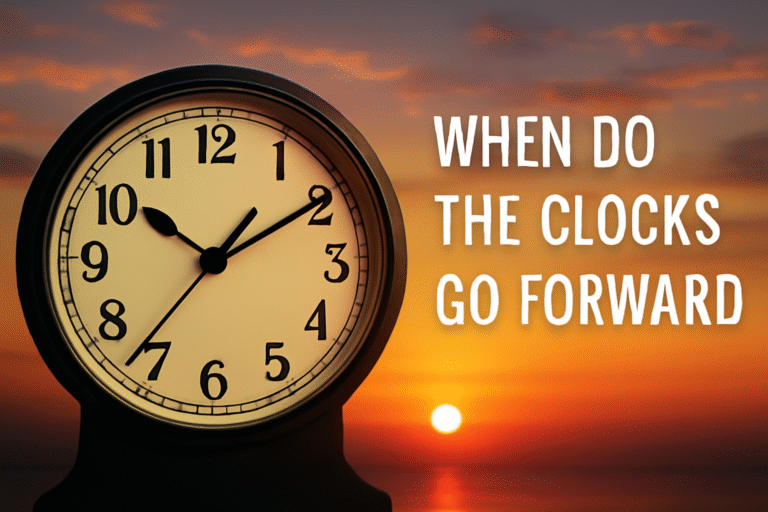
Ever wondered why the clocks change every year? Twice a year, we “spring forward” in March and “fall back” in October, but why? Well, it all has to do with Daylight Saving Time (DST), a practice that has evolved over centuries. In this article, we’ll explore why the clocks change, the fascinating history behind it, and how it impacts us today.
When Do the Clocks Go Forward?
Clocks go forward in March every year as part of Daylight Saving Time (DST). In 2025, the clocks will go forward on March 30, 2025, at 1 AM, marking the beginning of British Summer Time (BST). This means that we will lose an hour of sleep, as the clocks “spring forward” by one hour. The shift allows us to make better use of daylight during the warmer months.
When Do the Clocks Change in 2025?
For most countries that observe DST, the clocks will change as follows:
- March 30, 2025: The clocks will go forward by one hour at 1 AM, marking the start of British Summer Time. Unfortunately, this means we lose an hour of sleep!
- October 26, 2025: The clocks will go back by one hour at 2 AM, giving us an extra hour to rest.
In the United States, the clocks change a little earlier:
- March 9, 2025: Clocks go forward at 2 AM.
- November 2, 2025: Clocks go back at 2 AM.
Why Do We Change the Clocks?
The idea behind changing the clocks began over 100 years ago and has roots in both energy conservation and social efficiency. The idea is simple: by shifting the clocks, we can take advantage of longer daylight hours during the summer and reduce the need for artificial lighting in the evening.
A Historical Look: The Origins of DST
- Benjamin Franklin (1784): The concept of changing the clocks was first suggested by Franklin, who joked that people should wake earlier to save on candles. While his suggestion was humorous, it sparked serious interest in the idea of optimizing daylight use.
- William Willett (1907): A British builder, Willett took the idea seriously and campaigned for the clocks to be moved forward in spring and back in autumn. His proposal led to the introduction of British Summer Time in 1916, though he didn’t live to see it implemented.
- World War I (1916): During the First World War, Germany became the first country to officially adopt DST to conserve fuel. The UK followed soon after, and many other countries soon adopted similar practices.
The Pros and Cons of Changing the Clocks
While DST was initially adopted for practical reasons, it has sparked ongoing debates. Here are some of the pros and cons of changing the clocks:
When Did the Clocks Start Changing?
The practice of changing the clocks began as a wartime measure during World War I, but the idea of shifting time goes back even further. Here’s a quick historical timeline:
- 1784: Benjamin Franklin first proposed the idea of using natural daylight more efficiently, though in a playful manner.
- 1907: William Willett campaigned for the first formal proposal to move clocks forward in the spring and back in the fall.
- 1916: The Summer Time Act was passed in the UK, officially adopting DST.
- 1941-1945: During WWII, the UK experimented with Double Summer Time, moving clocks forward by two hours to maximize daylight during wartime.
Will the Clocks Ever Stop Changing?
The debate over whether to continue the practice of changing the clocks continues, especially in the United States and European Union. In the US, there have been proposals to make DST permanent, eliminating the need for seasonal clock changes. The EU has also been discussing ending the practice, with some countries opting to stay on permanent standard time.
For now, though, we’ll continue to see the clocks change twice a year.
Fun Facts About Clocks and Time Changes
- The Royal Observatory in Greenwich, UK, keeps its clocks set to Greenwich Mean Time (GMT) all year round, even during British Summer Time.
- Arizona and Hawaii are the only US states that do not observe DST.
- The Dolphin Sundial at the Royal Observatory is adjusted four times a year to reflect the changing of the clocks.
Conclusion: Why It Matters
Changing the clocks is a practice that has its roots in both energy efficiency and making better use of daylight. While some argue that it’s an outdated practice, it still remains in place due to its benefits for leisure, energy consumption, and even safety. As we move forward, the debate about its relevance will continue, but for now, we’ll all “spring forward” and “fall back” every year.





